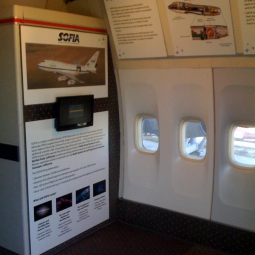In fall 2010, displays depicting the history and achievements of NASA’s Stratospheric Observatory for Infrared Astronomy (SOFIA) were installed at three Northern California venues – NASA Ames’ Exploration Center, the Ames Aerospace Encounter, and the Hiller Aviation Museum. One year later, more than 150,000 guests have seen the displays and had an introduction to astronomy at infrared wavelengths.
The NASA Ames Exploration Center at Moffett Field provides visitors with a glimpse into the science of NASA and the research accomplished at NASA Ames. Here, more than 50,000 visitors have seen the SOFIA one-fifteenth-scale model used in the NASA Ames 14-foot wind tunnel to predict properties of airflow over the open telescope cavity. This model was first used to test the potential of having the telescope cavity in the nose of the aircraft as it was in SOFIA’s predecessor, the Kuiper Airborne Observatory. The model was later reconfigured to reflect SOFIA’s final design with the telescope in the left waist section and was extensively tested to see how air flows over the open telescope cavity.
In addition to the wind tunnel model, the SOFIA display features a pair of cameras that show images of visitors in both visible and infrared light. “It’s incredible to watch the public engage and become excited by this display on infrared astronomy and SOFIA,” said Cara Dodge, Exploration Center manager. “Guests can see and understand how SOFIA’s capabilities enable scientists to look farther into, and learn more about, our universe.”
Along with the SOFIA exhibit, the Exploration Center features an International Space Station mock-up, a genuine Moon rock (recovered during Apollo 15’s expedition to the Hadley-Apennine region), a Mercury Redstone 1A (MR-1A) space capsule that was launched on Dec. 19, 1960, space suits, flying helmets, and a 100-seat immersive theater with 14-foot tall and 36-foot wide wrap-around screen. Visitor information can be found at: http://www.nasa.gov/centers/ames/home/exploration.html
“Field Trip Favorite”
The NASA Ames Exploration Encounter (AEE) is a unique educational program designed to inspire positive attitudes about science, technology, engineering and math for students in the fourth through sixth grades. The AAE is located in the old 6-foot by 6-foot supersonic wind tunnel and is a docent-led, field trip experience for students. More than 15,000 students have experienced the SOFIA display since September 2010.
“The SOFIA exhibit is a fieldtrip favorite! There are so many students (and chaperones) that are completely amazed to learn about and experiment with the IR universe. Once they understand infrared, we then can connect the concepts to the unique laboratory that is SOFIA, transforming it from ‘some NASA plane’ to an exhilarating and incredible research tool,” said AAE Operations Manager Brenden Sanborn.
At the AAE, students experience four hands-on educational stations: Exploring Physics, Exploring Flight, Exploring Space, and Exploring Earth. The SOFIA exhibit crosses-over all four themes and consists of a looping video about the aircraft and its science, a visible light camera paired with an infrared camera, and a series of educational panels showing the infrared spectrum as well as comparison photos of every day objects seen in visible light and in the infrared. More information about field trips to the AAE can be found at: http://www.nasa.gov/centers/ames/education/programs/encounter/
SOFIA in a 747
The third, and certainly the most unusual display was installed in the nose section of a Boeing 747 at the Hiller Aviation Museum, which is located less than 20 miles north of NASA Ames along Highway 101 at the San Carlos Airport. The museum features more than 50 full-size aircraft ranging from an 1869 Avitor steam-powered airship replica to the Boeing Condor, a super secret robotic spyplane from the 1980s. The Condor has a wingspan more than 200-feet-wide, which is larger than that of a 747. In addition to the aircraft, the Hiller Aviation Museum features other aviation technologies, such as engines and rotorcraft, and offers many great educational programs.
Through a series of large donations to the Hiller Aviation Museum, enough money was raised to acquire the double-deck nose section of a former British Airways Boeing 747. The aircraft was in storage at Roswell, N.M., where the nose was removed from the fuselage, sectioned to enable it to travel cross-country on a wide-load trailer, and was delivered to the museum in San Carlos. There it was reassembled and restored by museum volunteers and skilled tradespeople from United Air Lines.
The SOFIA display is located in the seating area in the front of the former business class section of the 747. Here visitors see an overview video that details SOFIA’s history and the types of objects the observatory studies while in flight. There are also panels about the electromagnetic spectrum, why NASA built a flying observatory, the observatory’s interior layout, how SOFIA inspires educators and the next generation of students through its Airborne Astronomy Ambassadors program, and information on other special use 747s.
“The SOFIA interpretive station is an integral part of the museum’s Boeing 747 exhibit,” said Jon Welte, Hiller’s Education Programs director. “It provides an easy-to-understand description of both the SOFIA aircraft and infrared astronomy, and illustrates a unique application of the Boeing 747 that is being used today as an important tool of scientific research.”
To date, more than 75,000 visitors and 11,000 school students have seen the SOFIA exhibit inside the 747 cockpit. Details about the Hiller Aviation Museum, its collection, and its educational programs can be found at: www.hiller.org .
Educational Opportunities
SOFIA offers a number of resources and programs for schools and educators, ranging from classroom speakers, to downloadable presentations and posters on the electromagnetic spectrum and SOFIA science, to the Airborne Astronomy Ambassadors program where educators are able to participate in SOFIA science during flights. Details on SOFIA’s free educational resources can be found at www.sofia.usra.edu under the Education and Public Outreach tab.
—Nicholas A. Veronico
SOFIA Science Center

